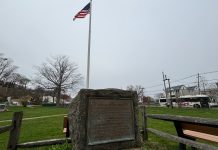By John Burton
FORT HANCOCK – The National Park Service is taking a major step toward looking for tenants to occupy and rehabilitate the aging historic structures at Fort Hancock – a step that could result in private homes at the site.
The National Park Service announced this week it will be seeking formal requests for proposals for six buildings at the former military installation, including those who are interested in using some of the buildings for residential use. The move is the park service’s first attempt in more than a decade – and the first since establishing the Fort Hancock 21st Century Advisory Committee in September 2012 – to rehabilitate the deteriorating structures.
“It’s a very big first step and one we don’t take lightly,” said John Harlan Warren, a spokesman for the National Park Service (NPS).
During what will be phase one of a pilot program for a redevelopment process, the NPS is seeking requests for proposals, called RFPs, for six of the 33 structures at the site that it hopes will result in finding tenants.
The RFPs are broken down into three categories, each offering two buildings for adaptive re-use. One RFP would be for two buildings for residential use; two to be considered for not-for-profit activities; and two to be fixed up and used for for-profit bed-and-breakfast businesses.
“We think it’s the right way to go and the right pace to do this so we can do this right,” Warren said of the phased approach.
Gerard Glaser, who co-chairs the Fort Hancock 21st Century Advisory Committee, agreed that the move was “a very big step forward … We’re all very encouraged by this.”
The plan and the types of activities the park service is hoping to attract grew out of the requests for “expressions of interest” the park service solicited last year.
According to Warren, the NPS received 41 proposals which offered general outlines for a variety of uses, including various private businesses, like B-and-Bs and as locations for an array of educational and not-for-profit uses.
The largest number of requests of interest was for residential uses, he said.
“I will say that the park was excited about that,” Glaser said. The residential use of the property could turn the site into a real community, he said. “And the park and the committee are very excited about the idea of building a community out there.”
Fort Hancock was an active U.S. Army installation for many years, which included families of the service members stationed there. Until Super Storm Sandy heavily damaged the site and some structures in October 2012, some park service employees and their families resided there.
The site already has a child day care facility, a high school (Marine Academy of Science and Technology, or M.A.S.T.) and the offices for some not-for-profit organizations.
“There is such growth potential to have it revived as a community once again,” Glaser said.
The park service will be seeking RFPs probably through the fall, Warren said.
“I hope by early 2015 the park would have received responses and will begin the evaluation process,” Glaser said, adding the park service “would like to move very quickly” on this.
The park service will see how the pilot program goes to determine how it should proceed with possible future uses of other fort structures, Warren said.
“The point of the pilot program is to find out what works, how to do things in the most efficient way and the way that preserves the buildings,” he said, “but also serves the lease holders and finds those happy mediums.”
Those selected to use any of the six buildings will be responsible for renovating them and will have to adhere to the requirements of the U.S. Department of the Interior for historic structures, Warren said.
The length of the leases for the buildings will be negotiated along with the price, based upon calculations made by the park service that will take into consideration fair market value and the cost of rehabilitation, Warren said.
Many of the buildings at Fort Hancock date back to the late 1800s and early 20th century when it was an active military installation, intended to provide defense of New York Harbor. In 1974 the site was decommissioned and came under the NPS’s Gateway Recreation Areas in New York and New Jersey.
The fort is listed on the National Register of Historic Places as a national historic landmark. Over the years the buildings have aged and deteriorated to the point where many cannot be used. Super Storm Sandy inflicted additional damage to many of the structures.
Park service officials have said in the past that it lacked the necessary funding to care for the buildings and had looked to find a public/private partnership that would allow for the buildings to be renovated.
A lease agreement with a private developer in 1999, however, became mired in acrimony, controversy and a lengthy legal battle in federal court with those opposing the plan and resulted in the federal government eventually terminating the agreement.














